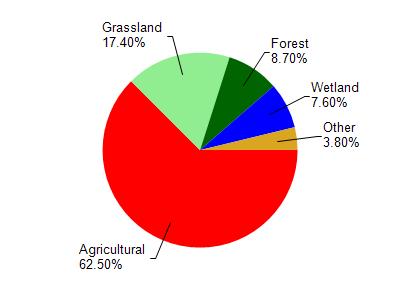Sheboygan
No
No
No
Fish and Aquatic Life
Overview
ONION RIVER HINGHAM MILLPOND AT RM 28.3
T14N R22E Sec. 31 Surface Acres = 38 Maximum Depth = 6 ft.
This is the downstream-most dam on the Onion River and has a sill height of six feet. The dam is located on the north side of Hingham just upstream of CTH I. The condition of the dam is undergoing an evaluation by WDNR dam safety personnel. No recent water quality information has been collected on the Hingham impoundment.
A sediment quality assessment was conducted by WDNR on June 29, 1999 on the Hingham Impoundment, Onion River (Table 36). Three sample sites were sampled in the soft sediment that has accumulated behind the dam. Samples were collected 30, 45 and 60 meters upstream from the dam.
Date 2001
Author Aquatic Biologist
Historical Description
Source: 1968, Surface Water Resources of Sheboygan County Hingham Millpond T14N, R22E, Section 30, 31 Surface Acres = 38, S.D.F. = 2.66, Maximum Depth = 6 feet The southernmost of two flowages on the west branch of the Onion River. The impoundment is created by a dam with a head of six feet. The bottom consists primarily of gravel and muck with some sand. Extreme shallowness, turbidity, and periodic algae blooms are major use problems. Some northern pike are present. However, to what degree these species are found within the flowage proper is relatively unknown. Fair numbers of migrating puddle ducks benefit from the back water provided. Hunting is permitted, and one town, public access with parking is available.
Date 1968
Author Surface Water Inventory Of Wisconsin
Condition
Wisconsin has over 84,000 miles of streams, 15,000 lakes and milllions of acres of wetlands. Assessing the condition of this vast amount of water is challenging. The state's water monitoring program uses a media-based, cross-program approach to analyze water condition. An updated monitoring strategy (2015-2020) is now available. Compliance with Clean Water Act fishable, swimmable standards are located in the Executive Summary of Water Condition in 2018. See also the 'monitoring and projects' tab.
Reports
Management Goals
Wisconsin's Water Quality Standards provide qualitative and quantitative goals for waters that are protective of Fishable, Swimmable conditions [Learn more]. Waters that do not meet water quality standards are considered impaired and restoration actions are planned and carried out until the water is once again fishable and swimmable
Management goals can include creation or implementation of a Total Maximum Daily Load analysis, a Nine Key Element Plan, or other restoration work, education and outreach and more. If specific recommendations exist for this water, they will be displayed below online.
Monitoring
Monitoring the condition of a river, stream, or lake includes gathering physical, chemical, biological, and habitat data. Comprehensive studies often gather all these parameters in great detail, while lighter assessment events will involve sampling physical, chemical and biological data such as macroinvertebrates. Aquatic macroinvertebrates and fish communities integrate watershed or catchment condition, providing great insight into overall ecosystem health. Chemical and habitat parameters tell researchers more about human induced problems including contaminated runoff, point source dischargers, or habitat issues that foster or limit the potential of aquatic communities to thrive in a given area. Wisconsin's Water Monitoring Strategy was recenty updated.
Grants and Management Projects
| Project Name (Click for Details) | Year Started |
|---|
|
|
Monitoring Projects
| WBIC | Official Waterbody Name | Station ID | Station Name | Earliest Fieldwork Date | Latest Fieldwork Date | View Station | View Data |
|---|
| 52200 | Hingham Mill Pond | 10005801 | Hingham Mill Pond | 9/8/2000 | 8/30/2017 | Map | Data |
|

Watershed Characteristics
Hingham Mill Pond is located in the Onion River watershed which is 98.00 mi². Land use in the watershed is primarily agricultural (62.50%), grassland (17.40%) and a mix of forest (8.70%) and other uses (11.40%). This watershed has 132.85 stream miles, 143.10 lake acres and 5,098.92 wetland acres.
Nonpoint Source Characteristics
This watershed is ranked Not Available for runoff impacts on streams, Not Available for runoff impacts on lakes and High for runoff impacts on groundwater and therefore has an overall rank of High. This value can be used in ranking the watershed or individual waterbodies for grant funding under state and county programs.However, all waters are affected by diffuse pollutant sources regardless of initial water quality. Applications for specific runoff projects under state or county grant programs may be pursued. For more information, go to surface water program grants.